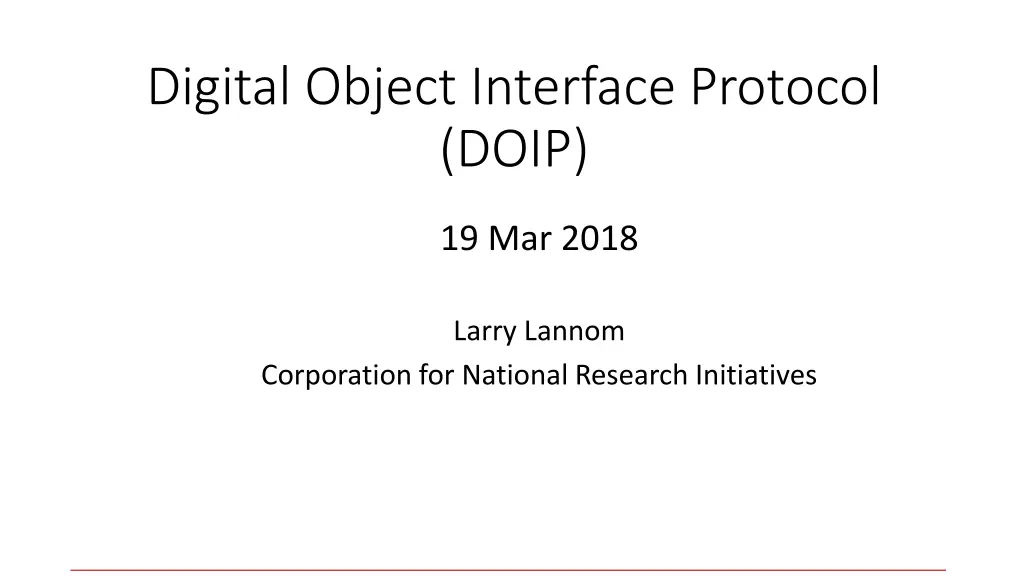
Digital Object Interface Protocol (DOIP) Implementation Insights
Explore the implementation details of Digital Object Interface Protocol (DOIP) covering the need for a common protocol, usage scenarios, and its current implementation by CNRI in Cordra versions. Learn about the essential elements such as CallerID and ObjectID, along with the input and output specifications of DOIP operations.
Download Presentation

Please find below an Image/Link to download the presentation.
The content on the website is provided AS IS for your information and personal use only. It may not be sold, licensed, or shared on other websites without obtaining consent from the author. If you encounter any issues during the download, it is possible that the publisher has removed the file from their server.
You are allowed to download the files provided on this website for personal or commercial use, subject to the condition that they are used lawfully. All files are the property of their respective owners.
The content on the website is provided AS IS for your information and personal use only. It may not be sold, licensed, or shared on other websites without obtaining consent from the author.
E N D
Presentation Transcript
Digital Object Interface Protocol (DOIP) 19 Mar 2018 Larry Lannom Corporation for National Research Initiatives
High-Level View of Digital Object Infrastructure ID: 843 G (object:publication) Identifier Service Identifier Service ID: 987/ DOIP Repo/Registry Repo/Registry Repo/Registry 101110010101001010 010101010101010100 010101010101010100 111110101101010111 Identifier Service Repo/Registry Repo/Registry (object:dataset) ID: 123 ID: XZY ID: 876 A A ID: HGY A (object:collection) End users, developers, and automated processes deal with persistently identified, virtually aggregated digital objects, including collections which are overlays on multiple network services which in turn are overlays on existing or future information storage systems.
DOIP: Why Do We Need This? Full realization of a Digital Object level of abstraction requires a common protocol Basic access to and operations on an object should not vary according to current environment Portability of objects is not sufficient moving an object from one repository to another should not change its behavior Changing the underlying technology for a repository should not change the behavior of an object Common protocol will drive normalization of common DO attributes and behavior Network effect - DOs that respond to the protocol will drive protocol adoption Network effect Spread of the protocol will drive the creation of compliant objects Use Cases Interacting with repositories, which are themselves DOs Create, Retrieve, Update, Delete, List DOs as compute engines, service providers Routing DOs in a workflow Query for attributes Write state data into the DO as needed
DOIP Implementation CNRI current implementation embedded in Cordra v1 Cordra v2 in beta (running across three different projects) HTTP/JSON Protocol buffers (release version TBD) bits on the wire (TBD) Additional implementations more than welcome Basic elements CallerID: The identifier of the entity requesting invocation of the operation ObjectID: The identifier of the object to be operated upon OperationID: The identifier that specifies the operation to be performed Input: A stream of bytes that contains the input to the operation, including any parameters, or content Output: A stream of bytes that contains the output of the operation, including any content or messages. Assumes Types, PIDs
DOIP: A Brief History Managing Access to Digital Information: An Approach Based on Digital Objects and Stated Operations - The Cross-Industry Working Team (XIWT), May 1997 By delineating specific types of operations that may he performed on digital objects that is, stated operations a basis may emerge for orderly management of rights associated with digital objects and their contents Digital Object Protocol Specification: Version: 1.0 November 12, 2009 ...the protocol and authentication mechanism used to interact with digital objects through a connection to a digital object server. Each interaction consists of a caller invoking or applying an operation on a digital object. The server, caller, each operation, and the object itself are all uniquely identified using Handle Identifiers. Framework for discovery of identity management information - ITU-T x.1255, 2013 (note: DE = DO) Each interaction with an instance of a DE consists of invoking or applying an operation on the DE.
